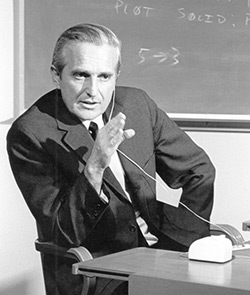Farewell
Paul L. Chambré (Ph.D.’51 ME) died in April. A professor of nuclear engineering and applied mathematics at Berkeley, Chambré led research in the fields of applied mathematics, neutron transport and mathematical modeling for reactor safety.
Garniss H. Curtis (B.S.’42 MSE) died in December at the age of 93. In addition to his engineering degree, he earned a Ph.D. in geology. Among his achievements was refining the method of argon-argon dating used to establish the age of Lucy, the famous Australopithecus. He later established the Berkeley Geochronology Center, considered among the most important dating labs in the world. Curtis retired from the UC faculty in 1989.
 Douglas Engelbart (M.S.’53, Ph.D.’55 EECS) died in July in Atherton, California. Engelbart is most well-known for inventing the computer mouse in 1964, but he also made invaluable contributions to the development of the personal computer and the Internet. He was recognized as a visionary, revolutionizing interactive computing and information networking during a long career. He was honored with numerous awards, including the National Medal of Technology, the United States’ most prestigious technology award.
Douglas Engelbart (M.S.’53, Ph.D.’55 EECS) died in July in Atherton, California. Engelbart is most well-known for inventing the computer mouse in 1964, but he also made invaluable contributions to the development of the personal computer and the Internet. He was recognized as a visionary, revolutionizing interactive computing and information networking during a long career. He was honored with numerous awards, including the National Medal of Technology, the United States’ most prestigious technology award.Alton Carl (“Tony”) Engel (B.S.’43 ME) died in March at age 92. Engel served in the U.S. Navy during World War II and later opened his own engineering firm. He continued to work full-time beyond his 92nd birthday.
George T. Foster Jr. (B.S.’67 EECS) died this year at the age of 68. Foster worked on spacecraft science instruments at the Pasadena Jet Propulsion Laboratory. In 1998, Foster began Professional Design and Associates, an electrical engineering consulting firm in Henderson, Nevada.
Nelson L. Hansen (B.S.’54 CE) died in June. Hansen served his tour in Germany with the Army Corps of Engineers. After retiring from Montgomery Watson Engineers of Walnut Creek, Hansen enjoyed hunting, camping and fishing.
John Mason Harker (M.S.’52 ME) died in April at the age of 86. Harker attended Berkeley for one semester, enlisted in the Navy and served as an electronics repair specialist during World War II, returning to campus after the war. At IBM, he helped develop the world’s first hard-disk drive; he eventually became the director of technology and an IBM Fellow.
Raymond Itaya (B.S.’52, M.S.’57 CE) died in January at age 81. Itaya served in the U.S. Army Corps of Engineers during the Korean War. After the war, Itaya returned to Berkeley to receive his master’s degree and later to work at Lawrence Livermore National Laboratory.
Paul Folsom Jones (B.S.’65 CE) died in May. After earning his MBA from the Haas School of Business in 1970, Jones worked for the Irvine Company. He later sold real estate. Jones then relocated to Flagstaff, Arizona, where he joined the faculty of Northern Arizona University as an adjunct professor in the humanities.
William J. Jurkovich (B.S.’44 CE) died in March at age 91. Attending Berkeley on an athletic scholarship, Jurkovich graduated with academic honors. After serving as a lieutenant in World War II, he joined the California Division of Highways as a resident engineer, but was called back to serve in the Korean War. He played a key role in bringing pre-stress concrete bridge design to California, winning a national award in steel bridge design. He completed his 47-year Caltrans career in 1993.
Peter L. Newberg (B.S.’51 ME) died in March at age 90. Newberg joined the U.S. Navy on his 18th birthday and took part in the historic battles of the Coral Sea and Midway. Newberg worked for the Standard Oil Company and Occidental Petroleum.
George A. Rustigian (B.S.’51 CE) died in April at age 87. After graduation, he served in the Army Air Corps as a cadet in World War II. Rustigian worked as a civil engineer, and in 1962, he became co-general manager of his wife’s family business, Casper’s Famous Hot Dogs.
Thomas Stelzner (B.A.S.’44, B.S.’47 ME) died in May at age 89. Stelzner spent two years in the U.S. Navy during World War II before completing his education at Berkeley. He then spent 38 years with Chevron. After he retired in 1985, Stelzner developed his farm near Sebastopol, California.
Donald J. Unger (B.S.’48 IEOR) died in April at age 91. He served in the U.S. Army Air Corps as a pilot during World War II and in the U.S. Air Force during the Korean War. He started Cedar Ridge Building Materials Co. in 1973. Unger was also the co-founder of Nevada County’s Habitat for Humanity ReStore, a nonprofit home improvement store dedicated to helping build homes and communities.

